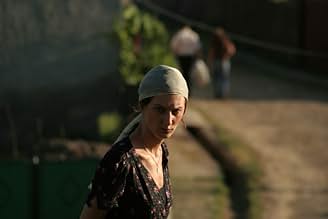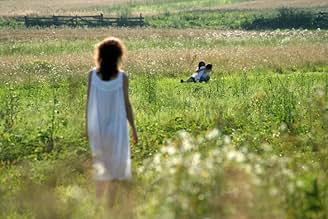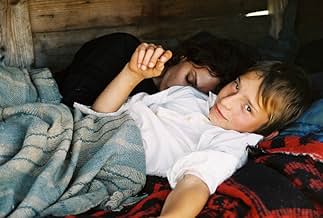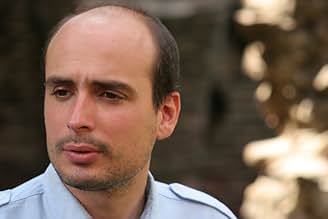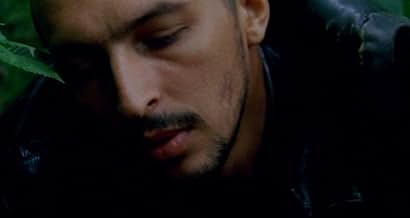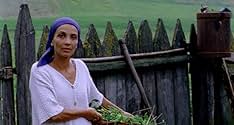Katalin Varga
- 2009
- Tous publics
- 1h 22min
NOTE IMDb
7,0/10
3,2 k
MA NOTE
Ajouter une intrigue dans votre langueKatalin, a woman raped in the Carpathian Mountains, seeks revenge with a boy, questioning morality's complexities as she confronts her past.Katalin, a woman raped in the Carpathian Mountains, seeks revenge with a boy, questioning morality's complexities as she confronts her past.Katalin, a woman raped in the Carpathian Mountains, seeks revenge with a boy, questioning morality's complexities as she confronts her past.
- Réalisation
- Scénario
- Casting principal
- Récompenses
- 14 victoires et 16 nominations au total
Tibor Pálffy
- Antal Borlan
- (as Tibor Pálfy)
Avis à la une
't easy to follow, since a lot of the plot and background story is told little by little.
But the visuals is enough to watch this film. The cinematography and composition is something I haven't seen in a while. I gather the film was shot on 16mm, but that doesn't bother at all. On the contrary, it gives a small personality to the film.
The only weaknesses which I found were in the script. It's somehow difficult to follow, although understandable. But, because it was difficult to follow, it was difficult to get emotionally attached.
But as an art house film, it is a must see. Maybe not for the big public, but for the film buff.
But the visuals is enough to watch this film. The cinematography and composition is something I haven't seen in a while. I gather the film was shot on 16mm, but that doesn't bother at all. On the contrary, it gives a small personality to the film.
The only weaknesses which I found were in the script. It's somehow difficult to follow, although understandable. But, because it was difficult to follow, it was difficult to get emotionally attached.
But as an art house film, it is a must see. Maybe not for the big public, but for the film buff.
Peter Strickland's debut movie Katalin Varga reminds me very much of another recent British film, Asif Kapadia's 2007 effort Far North, which is also a folk horror story about an outcast and her child. Stickland uses the dank forest of Romania instead of the perilous ice flows of the north, but the movies are birds of a feather, low budget movies intended to tap primal energies.
Children run away from Katalin Varga, a darkly pretty woman with live-wire eyes, who's altogether too spirited to remain unmolested in the time-capsuled world with which the movie presents te viewer. Folk have mobile phones, but Katalin still travels by horse-drawn cart, and men still make hay in the fields with pitchforks. Gossip in Katalin's village is poisonous enough to make Clouzot's vision in Le Corbeau appear positively made of marshmallow. Following the repurcussions of gossip regarding Katalin's past, she travels with her child into an apparently infrastructure-less hinterland on a dark mission, like black lightning.
It's no surprise to find, following shot after shot of foreboding nature scenes, that this is a tragedy, in a cul-de-sac structure similar to Monte Hellman's brilliant 1965 movie Ride in the Whirlwind.
It's a brutal movie, in structure rather than in screen violence, which there is remarkably little of, and which is generally obscured in incoherence when it occurs. It's almost senseless and left me with a directionless primitive anger.
Children run away from Katalin Varga, a darkly pretty woman with live-wire eyes, who's altogether too spirited to remain unmolested in the time-capsuled world with which the movie presents te viewer. Folk have mobile phones, but Katalin still travels by horse-drawn cart, and men still make hay in the fields with pitchforks. Gossip in Katalin's village is poisonous enough to make Clouzot's vision in Le Corbeau appear positively made of marshmallow. Following the repurcussions of gossip regarding Katalin's past, she travels with her child into an apparently infrastructure-less hinterland on a dark mission, like black lightning.
It's no surprise to find, following shot after shot of foreboding nature scenes, that this is a tragedy, in a cul-de-sac structure similar to Monte Hellman's brilliant 1965 movie Ride in the Whirlwind.
It's a brutal movie, in structure rather than in screen violence, which there is remarkably little of, and which is generally obscured in incoherence when it occurs. It's almost senseless and left me with a directionless primitive anger.
Great, atmospheric effort from Strickland. I can only imagine he had some affinity with this part of Romania whether from childhood or other. The soundtrack and some of the slow lingering shots (esp. the scene looking at child, mother and horse not moving from behind, and the forest shot) were very affecting, and reminded me of Tarkovsky (not in a bad way ;)I got to thinking of the inextricable nature of all things, of how everything (as a single glorious 'entity') was so deviously and religiously bound up that to even attempt to extract something from it was tantamount to destructuring the whole (and thus destroying its royalty). That a film can inspire me (it has to be said not single-handedly)to such ends is indicative of a deep metaphysical quality within it.There is a particular sentence that the man utters towards the end of the film that resonates deeply towards this metaphysis. I shan't explicate it, nor even repeat it, but you shall know it when you hear it.
Thanks for this Strickland, and all who were involved in and outside it (even the guy who carted the extra film stock when, presumably, you ran out ;) 'Ultimately, there are no parts at all.' Fritjof Capra, The Web of Life.
Thanks for this Strickland, and all who were involved in and outside it (even the guy who carted the extra film stock when, presumably, you ran out ;) 'Ultimately, there are no parts at all.' Fritjof Capra, The Web of Life.
I borrowed the DVD from a local store, being sure that this is going to be a good movie. I read good reviews of it. Now I'm quite disappointed after seeing it. The movie is good enough until the scene where the woman is telling her rape experience finishes. The story of the rape is the best part. As the camera focused on the characters' faces, Katalin tells her horrific story, disconnected from the suffering that we would expect. That gives the character a lot of power. She is in a position of control, she overcame the bad experience and her main weapon is the truth, because the truth will really ruin the precious relationship of Katalin's aggressor with his wife. The story of the rape is told in such intimate detail, that you may feel various emotions, like empathy, justice being done, concern for any of the characters, each of them may be in a dangerous position. The situation is very much like one from Sadoveanu's novel "Baltagul". After this wonderful artistic moment, the rest of the movie is full of broken links. The man's regret for what he has done is very unrealistic, not that this might not happen in real life, but his state is not supported by the play and the character's story. Then, the suffering for the loss of his wife is too short. The wife, a devoted Christian, commits suicide (that's possible, but not very probable) without many explanations given to us. The man suffers too little after that because he is quite preoccupied with his relation with Katalin and her son. Many other disharmonious details disconnected me from the movie. I also have some personal regrets, that the Romanians in the movie are all mean characters. There's no obvious reason in a movie where 99 percent of the time you have Hungarian language speaking, only three short but significant dialogues are in Romanian. In one of them we have the girls eating sunflower seeds that are not helping the strangers in need without judging or mocking them. Eating sunflowers in public in Romania is associated with low class, specially because it's a Balkan habit mostly associated with gypsies. Speaking of gypsies, I can not get over the idea that the first victim of Katalin is associated with Gypsies and undoubtedly this is part of the construction of an evil character. The other two scenes with Romanians are the ones involving the vengeful criminals, one of them showing a twisted faith in God. Anyway, it could have been a good movie, but amateurish errors and a bit of xenophobia (I suppose) ruined it for me. I may keep in mind as good parts: landscapes, music and the boat scene.
Having already seen and very much enjoyed this director's Berberian Sound Studio and prior to seeing his latest, The Duke Of Burgundy, decided to check out this, his first feature. Glad I did, seems it didn't get a theatrical release in UK, which is a travesty. Great little film, very focused, very intense, with a stunning central performance from Hilda Peter. Problems in her village prompt her to take off with her son and traverse the Carpathians and maybe exorcise her devils. Always very good to look at, this also has what has become a Strickland trademark, amazing score. The tinkling cowbells, echoing across the fields or the creak of the horse and cart carrying them both find their way unobtrusively into the score. Always engrossing, the central sequence where the main character explains graphically what happened to her as their boat slowly spins on a lake is spellbinding and so very effective. Excellent.
Le saviez-vous
- AnecdotesThe film was shot in Romania in July 2006 for around £25,000 with a small crew of 11 people (including transport and catering). Strickland paid everyone on the 17-days-shoot himself, apart from the focus-puller, who agreed to work for free. The whole crew and the actors lived together in an empty house in a small village in the Carpathian Mountains. After the shoot Strickland ran out of money while editing. He approached many UK production companies, but the reaction was always negative because an obscure film by an unknown director, not even in the English language, seemed to put off all UK investors. Only two Romanian producers, Oana Giurgiu and Tudor Giurgiu, paid attention. They saw Strickland's rough cut and came on board as co-producers, providing the funds to make a proper sound-mix and a blow-up from the Super-16mm negatives to 35mm. It was then invited and shown in competition at the '59th Berlin International Film Festival' in 2009 and won the 'Outstanding Artistic Contribution' award for the creative sound design. Without the Romanian producers, the film would never have been properly finished.
- ConnexionsReferenced in Cowboy (2017)
- Bandes originalesThe Grave and Beautiful Name of Sadness
- excerpts taken from "The Sadness of Thing"
Written by Steven Stapleton and David Tibet
Performed by Steven Stapleton and Geoff Cox
Meilleurs choix
Connectez-vous pour évaluer et suivre la liste de favoris afin de recevoir des recommandations personnalisées
- How long is Katalin Varga?Alimenté par Alexa
Détails
- Date de sortie
- Pays d’origine
- Site officiel
- Langues
- Aussi connu sous le nom de
- 卡塔琳的秘密
- Lieux de tournage
- Sociétés de production
- Voir plus de crédits d'entreprise sur IMDbPro
Box-office
- Montant brut mondial
- 28 399 $US
- Durée
- 1h 22min(82 min)
- Couleur
- Mixage
- Rapport de forme
- 1.85 : 1
Contribuer à cette page
Suggérer une modification ou ajouter du contenu manquant


